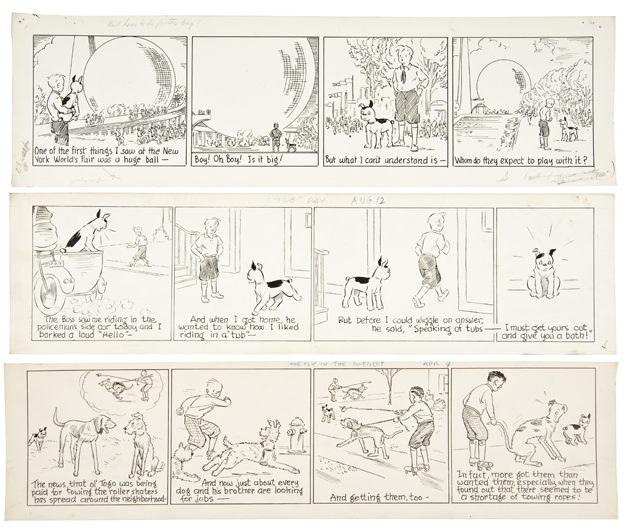Wooden pin depicting “Snubs the Dog” from The Christian Science Monitor cartoon. (1989.18).
The history of cartoons in newspapers spans back to the nineteenth century. Since that time, they have been both political and comical. In the earliest days of The Christian Science Monitor (the newspaper founded by Mary Baker Eddy in 1908), cartoons were not included. Instead, cartoons published in other newspapers were described in written form. Political cartoons courtesy of Punch, a British paper, ran irregularly in the Monitor as early as 1916,1 and political cartoons drawn specifically for the Monitor first appeared in 1919.2 These cartoons stopped the same year but then began running regularly again in 1922.3
One of the first non-political comics to run in the Monitor on a regular basis was “The Diary of Snubs, Our Dog,” written and illustrated by Paul R. Carmack (18 December 1895–22 September 1977). He “got his idea for Snubs while watching puppies in a pet store window in Chicago” (where he attended the Art Institute).4 The comic first appeared in The Prairie Farmer, a Chicago newspaper. Carmack was Art Director and Cartoonist there after serving in the Navy during World War I. Snubs began appearing in the Monitor in 1923 and Carmack joined the newspaper’s staff in 1925. By this time Snubs ran exclusively in the Monitor.
In his book Commitment to Freedom, the longtime Editor of the Monitor, Erwin Canham, described the process of running comics in the newspaper:
To create a regular comic strip for the Monitor took a bit of doing. The usual blood-and-thunder sequences were not welcome. The Monitor also had to have strips exclusive to itself, since it could not publish syndicated material that was available to readers of other newspapers before they could get the Monitor. Nearly all other newspapers simply buy comic strips from a syndicate. The total cost is spread over a large number. Elaborate teams of collaborators produce the famous strips. The Monitor must pay the entire cost of production of each of its strips.5
On August 31, 1954, Snubs (along with a few other Monitor comics) was suddenly stopped. As the Editor of the Monitor, Canham later explained his decision by stating the importance of keeping comics fresh, as well as saving money. “The Monitor…can obtain, at rates it can afford to pay, an excellent selection of drawings comparable to those for which the slick magazines pay a much higher figure. Compared to the paper’s former strips [such as Snubs], the humor is more adult, more professional, and yet entirely wholesome.”6 Canham also noted the reaction: “Readers who had been brought up on Snubs protested pathetically, despite the fact that Mr. Carmack had been forced to leave him [Snubs] to a contributing artist for some years. It was virtually impossible to retain his original verve and freshness.”7
The pin of Snubs that is found in our collections is contemporary folk art, made of a light wood with a safety pin attached on the back. It’s quite small at just 1 3/4″ length and 1” in width. Snubs’s spots are likely the product of wood burning. Unfortunately, we do not know anything about the origin of the piece, if it was ever worn, and if so, by whom. It was donated by a long-time employee of The Christian Science Publishing Society who worked approximately one decade at the Monitor in the 1930s and 40s. However, we do not know how she came by it, although it’s interesting to note that her donation also included copies of the Snubs, Our Dog, cartoon books.
Is it possible that the Snubs pin was crafted by Carmack or by one of the artists who later worked on the comic? We don’t know, so if anyone has more information on the creator of this piece, please contact the Research Room by e-mail at [email protected], call us at 617-450-7218; or write to us at 200 Massachusetts Avenue, P02-10 Boston, MA 02115.
- “A Willing Victim,”The Christian Science Monitor, April 28, 1916.
- Editorial Cartoon, Monitor, April 16, 1919.
- Editorial Cartoon, Monitor, February 3, 1922.
- “When Snubs and Tubby Ruled the Comic Pages,” Monitor, November 25, 1998.
- Erwin Canham, Commitment to Freedom: The Story of The Christian Science Monitor (Boston: Houghton Mifflin, 1958), 359-60.
- Ibid., 361
- Ibid.



